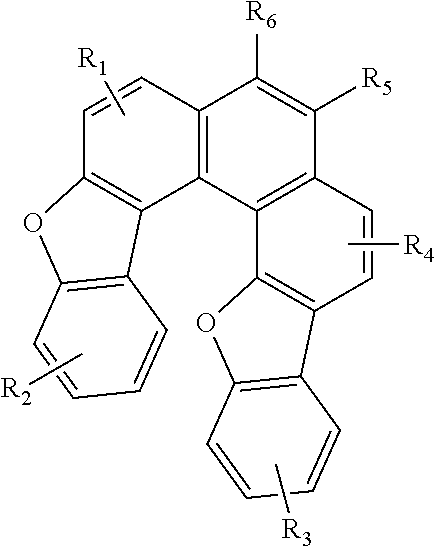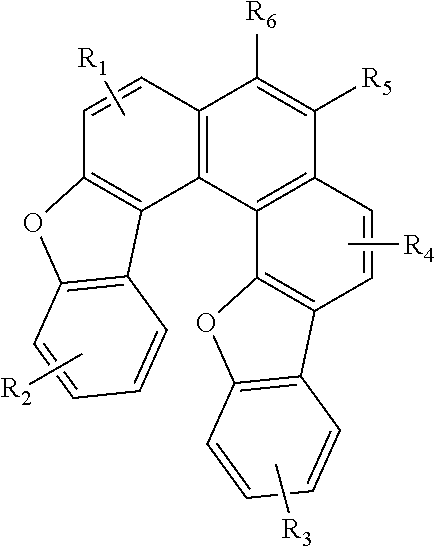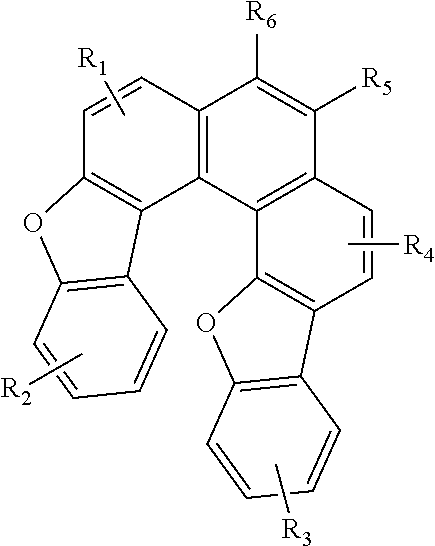Blue fluorescence dopant compound and organic electroluminescent device using the same
a fluorescence dopant compound and organic technology, applied in the field ofluminescent material technology, to achieve the effects of reducing driving voltage, increasing efficiency, and improving efficiency
- Summary
- Abstract
- Description
- Claims
- Application Information
AI Technical Summary
Benefits of technology
Problems solved by technology
Method used
Image
Examples
example 2
Compound Example 2
Synthesis of Compound 11
Synthesis of Intermediate O
[0073]
[0074]All experimental instruments were fully dried beforehand. 32.6 g brominated compound (1.1 eq.) was placed into a three-neck flask (2 L), to which 600 mL dry tetrahydrofuran was added to dissolve the solid. Then the resulting mixture was cooled down to −78° C. and 52.5 mL LDA solution (1.05 eq., 2M) in THF was added dropwise thereto. After conducting the dropwise addition, the resulting mixture was stirred at the above temperature for 1 hour, to which at the same temperature 27.9 g iodine (1.1 eq.) was then added dropwise. After conducting the dropwise addition, the resulting mixture was stirred overnight at room temperature, and then after the reaction finished, hydrochloric acid solution (4M) was added thereto. The resulting mixture was extracted with dichloromethane and the organic phase was washed with saturated aqueous NaCl solution until neutral and dried. After rotary evaporation of the solvent an...
example 3
Compound Example 3
Synthesis of Compound 23
Synthesis of Intermediate X
[0095]
[0096]3.6 g Mg (1.5 eq.), 16 mL THF, and 0.36 g I2 were placed into a dry three-neck flask (2 L) and the resulting mixture was heated to trigger reaction. Then a solution of 17.8 g tert-butyl bromide (1.3 eq.) in 180 mL THF was added dropwise, at room temperature, to the resulting mixture. After conducting the dropwise addition, the resulting mixture was reacted at 51° C. for 2 hours and was thereafter left to stand for 5 minutes. The supernatant was added dropwise to a solution of 32.6 g 1,6-dibromodiphenylfuran in 600 mL THF, and the resulting mixture was refluxed overnight for 15 hours, and after the reaction finished, it was cooled down to room temperature, quenched with drops of water, and extracted with a mixture of dichloromethane and water. The organic phase was washed with water and dried. The solvent was removed by rotary evaporation and the residual was purified by chromatography column to produce ...
example 4
Compound Example 4
Synthesis of Compound 47
Synthesis of Intermediate e
[0112]
[0113]3.6 g Mg (1.5 eq.), 15 mL THF, and 0.36 g I2 were placed into a dry three-neck flask (2 L) and the resulting mixture was heated to trigger reaction. Then a solution of 16.0 g 2-bromopropane (1.3 eq.) in 160 mL THF was added dropwise at room temperature. After the addition, the resulting mixture was reacted at 51° C. for 2 hours and was thereafter left to stand for 5 minutes. The supernatant was added dropwise to a solution of 32.6 g 3,7-dibromodiphenylfuran in 600 mL THF. The resulting mixture was refluxed overnight for 15 hours, then after the reaction finished, it was cooled down to room temperature, quenched with drops of water, and extracted with a mixture of dichloromethane and water. The residual phase was washed with water and dried. The solvent was removed by rotary evaporation and the residual was purified by chromatography column to produce 24.6 g Intermediate e in 85% yield.
Synthesis of Inter...
PUM
| Property | Measurement | Unit |
|---|---|---|
| brightness | aaaaa | aaaaa |
| temperature | aaaaa | aaaaa |
| temperature | aaaaa | aaaaa |
Abstract
Description
Claims
Application Information
 Login to View More
Login to View More - R&D
- Intellectual Property
- Life Sciences
- Materials
- Tech Scout
- Unparalleled Data Quality
- Higher Quality Content
- 60% Fewer Hallucinations
Browse by: Latest US Patents, China's latest patents, Technical Efficacy Thesaurus, Application Domain, Technology Topic, Popular Technical Reports.
© 2025 PatSnap. All rights reserved.Legal|Privacy policy|Modern Slavery Act Transparency Statement|Sitemap|About US| Contact US: help@patsnap.com



